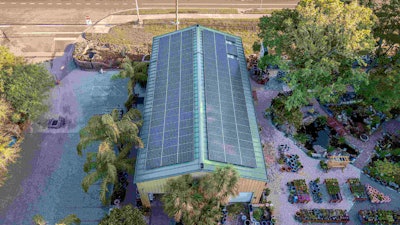 An aerial view of the newly installed solar panels on Earth Works’ garden center.
An aerial view of the newly installed solar panels on Earth Works’ garden center.Photo: Earth Works
To celebrate its 30th anniversary this year, Earth Works, a landscaping company based in Jacksonville, Florida, had 124 solar panels installed on its garden center before its Spring Garden Party.
While it may sound like a gimmick done in an attempt to attract some attention, Doug McGregor, president of Earth Works has been a proponent of solar power for years and had always been interested in using it.
It was when a young salesman with A1A Solar, a solar panel company based in Jacksonville, Florida, reached out to McGregor that he realized incorporating solar into his business was actually feasible.
After providing 12 months of previous statements from their electrical carrier to A1A, the solar panel company was able to show Earth Works how having the system installed wouldn’t cost any more than if they were paying for their current utilities with financing. McGregor discussed things with the bank and got an even better deal for financing.
“Probably the biggest thing was the value of our land had increased so much that it was easier to get financing on the new solar system and that’s what kind of prompted us,” McGregor said. “It was a no-brainer.”
From there, A1A’s engineers reviewed the company’s electrical requirements and installed the 36.6-kW photovoltaic system during the last two weeks of March. The system was operational March 30.
“They came out when they said they were going to do it, they got it done and then we had to wait approximately two weeks for them to get the meter put in,” McGregor said.
The new meter, known as a bidirectional meter, is able to track and record the energy the solar system is producing.
“The utility company doesn’t measure the solar,” said Pete Wilking, A1A’s founder and president. “It measures the electricity coming into the building, but it also measures electricity going back to the utility company in the form of excess energy above and beyond what the building uses.”
“I just like going down and seeing the little arrow going the other way,” McGregor laughed.
The panels produce an energy offset of 50,508 kWh/year, which provides approximately 50 percent of all Earth Work’s electric usage. As for the lifespan of the panels, McGregor says they come with a 25-year warranty. The maintenance is minimal, with an annual cleaning advised for maximum efficiency, but McGregor says A1A handles that.
While solar power comes across as something that can only be practical in sunny locations like Florida and Arizona, Wilking says any area in the United States is fair game.
The key is the amount of solar resource available. Southern regions and even the Northeast have plenty of solar resources available, but even the overcast Northwest can get the same amount of harvest if more panels are installed.
“I mean, look at Germany,” Wilking said. “They’ve got tons of solar and they have less resource than, say, New York State. They work even in low light conditions.”
The number of panels needed is also based on the amount of electricity the building consumes on an annual basis.
Wilking says that the biggest harvest occurs between 9 in the morning and 3 in the afternoon on average, but the panels work all day, even when it’s raining. The power output is simply reduced in the early morning, late afternoon or during periods of excessive cloud cover.
“Now where the rubber meets the road is the economics,” Wilking said. “That’s where the landscape company would need to work with a reputable local solar professional to get the scoop on how the economics are treated.”
Depending on the utility company, the billing structure, how the power is metered and other elements will determine if solar has a big enough economic payback for a landscaping company.
“The federal government still has its 30 percent federal tax credit that runs to the end of next year and then it drops down to 25 percent,” Wilking said. “There are substantial tax advantages, tax incentives, particularly on the commercial side, for going solar. So, there is a financial component to it. The utility company and how the customer is billed and their billing rate and billing structure is going to determine just how good the economics are.”
According to Wilking, a majority of people are initially afraid of solar because they believe it is too expensive, but as technology has progressed, the cost of solar panels has gone down and there is always the option of financing.
“When you finance a 30-year power production asset that really has very little, almost no cost of ownership in terms of maintenance, repair or support, you just have that one-time initial cost,” Wilking said. “When you spread that over at least a 10-year period, you typically get positive cash flow right out of the gate.”
While there is a lot to learn financially about solar power, enlisting the help of the company’s tax adviser or financial adviser can ensure the project gets the ideal positive cash flow from year one.
“From my standpoint, the more research somebody has done on solar, the easier it is for them to push the button,” Wilking said. “The more knowledge you have on the subject, the more it makes sense. The less knowledge you have, the more apprehensive people are.”
Once you are on board with installing solar power, Wilking says the most important ingredient in going solar is making sure you have a qualified contractor to design and install it properly.
Reputable solar panel installers will have good reputations and solid referrals from both recent projects and those done years ago. Wilking says another good indicator of a trustworthy operation is a company that has at least one or more people certified by the North American Board of Certified Energy Practitioners (NABCEF), which means they are going above and beyond state licenses.
“I would just say if you ever had an inclination to do solar, call a couple of qualified installers in the area and get just a free estimate,” McGregor said. “That’s what convinced us to do it and I’d do it again in a minute.”









